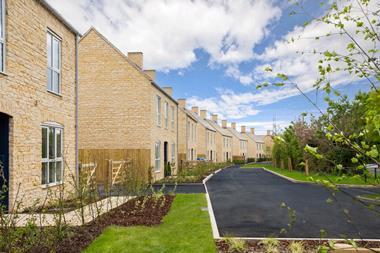In the five years since the first deals by institutional investors marked the birth of the build-to-rent (BTR) sector in the UK, the asset class has experienced phenomenal growth. The total number of BTR homes built, under construction or in planning across the UK increased by 30% in the past 12 months alone to 118,000, according to research carried out by Savills on behalf of the British Property Federation (BPF).

In 2012, when the Montague Review set out recommendations to increase the scale of institutional investment in the private rented sector, many in the industry saw the potential of BTR but few predicted that it would take-off to the extent that it has.
“I sat on the Montague Review and had no idea just how big the BTR sector would become,” says the BPF’s director of real estate policy, Ian Fletcher. “It is surpassing all our expectations.”
Renting purpose-built space from an institutional landlord has proved a popular option for a lot of people, while investors have flooded into the market in search of secure, long-term income. According to CBRE, investment in BTR in the UK reached £2.4bn in 2017, 33% up on the previous year.
So can the sector carry on growing at the same pace and what challenges lie ahead for what is now one of the property market’s hottest asset classes?
Jacqui Daly, a director in the investment research and strategy team at Savills, is confident that the sector’s rapid growth will continue. She predicts that at the current rate of growth, the BTR pipeline could double to around 200,000 within the next two years. “There is real momentum and we’re now seeing a significant number of projects reach completion,” she says.
Early developments such as Get Living’s East Village – the conversion of the Olympic Park’s athletes’ village into 1,500 BTR homes, at the heart of a new mixed-use community– have been trailblazers.
“We managed to prove the point that institutional investment can work in the rental sector and BTR is starting to snowball,” says Get Living chief executive Neil Young. “East Village has proved that BTR means more than delivering homes. It’s about thinking beyond the box people live in, creating a neighbourhood and responding to the whole lifestyle piece.”
Scaling up the concept
Other big developments have followed. For example, Quintain is building the UK’s largest BTR scheme at Wembley Park where it has consent for 8.8m sq ft of mixed-use development, including 5,000 homes to rent.
Michael Allen, managing director of Tipi, Quintain’s rental company, has extensive experience in the multi-family sector in the US and he believes the market conditions in the UK are ideal.
“[In the UK] everything is perfectly aligned from an investor and customer perspective,” says Allen. “Affordability to buy is a big issue and there is an endemic lack of quality stock in the places people want to live.”

Across London, many other developers have ambitious growth plans. Examples include US specialist Greystar’s plans to build and manage 10,000 BTR homes across the capital by 2022 and Grosvenor’s commitment to develop 1,350 homes in Bermondsey.
As the BTR sector evolves, operators are also increasingly looking beyond London for new opportunities. According to the BPF’s figures, the regions now account for 62% of all BTR units under construction.
“Regional cities such as Manchester are attracting significant BTR investment and that is extending to secondary cities such as Leicester, Southampton and Bristol,” says Iain Murray, managing director of consultancy firm LIV Consult. “As people see what can be achieved, tertiary towns of an adequate size will also support BTR development.”
Atlas Residential is one of the specialist BTR developers to have begun building in the regions. It has almost 1,000 BTR homes under construction in Southampton, Birmingham and Salford. Managing director Jonathon Ivory says locations where land values, construction costs and rents are at the right levels will be commercially viable.
“What matters is affordability and whether there is strong economic activity, access to transport and local amenities,” he says.
Range of tenants
The appeal of BTR is widening further as the market realises it can attract a broader range of people. As well as meeting the needs of city-living professional millennials, it can also work for young families unable to afford to buy, empty nesters and retirees.
Developers are now looking beyond high-density, city centre schemes to attract a broader range of tenants. Sigma Capital Group, for example, has carved out a niche developing BTR houses in partnership with major housebuilders throughout the North West, the Midlands and Yorkshire.
“We’re focusing on economically active working families who want to rent close to work and school,” says Rob Sumner, Sigma’s residential investment director. “We’re integrating these properties into areas starved of decent rental stock. That is appealing to a wider age group and those 46 or over now account for 26% of our occupants.”
Some operators hope to create schemes that appeal to the entire spectrum of occupiers.
“We’ve seen a sea change in the number of authorities supporting BTR”
Amanda Balson, Nexus
Manchester’s MCR Property Group is awaiting planning approval for its £250m New Monaco urban village in Birmingham’s Southside district, which will include more than 1,000 BTR homes.
“The community will comprise a mix of apartments and town houses,” says MCR fund manager Chris Taylor. “We want to create an environment that can accommodate people throughout their lives.
“Someone might start in a one-bed apartment after qualifying from university, move to a two-bed when they meet their partner and then take a three-bed apartment or town house when they start a family. We’re discussing whether we should design different fit-outs to appeal to different groups of people.”
If schemes like this are successful and BTR is able to attract a broad range of tenants, the sector could play a valuable role in addressing the UK’s housing crisis, adding a new type of housing that can be developed at a far quicker pace than build-to-sell.
“The government has upped its target from building 200,000 homes a year to 300,000 by 2025 and BTR could deliver a quarter of the annual housing shortfall,” says the BPF’s Fletcher.
Local level
Government policy is also helping to support the sector’s growth. The government’s Draft National Planning Policy Framework recognises BTR as a development type and requires local authorities to identify how many new homes for rent are required in their area.
At a local level, councils are also increasingly keen to back new BTR projects. Amanda Balson, executive director at consultant Nexus Planning, who has conducted research into the attitude of London authorities to BTR, says: “We’ve seen a sea change in the number of authorities positively supporting BTR. Many back that up with specific policies and some even regard it as a quasi-form of affordable housing.”

As well as benefiting from public sector backing, the range of funding options for BTR operators is growing. New institutional investors continue to enter the market, particularly from overseas, while more and more lenders are also willing to provide finance. Some banks have been reticent about the sector but many – including Joshua Weinstein, who works in the structured property finance team at Investec – believe they will soon start to play catch-up.
“The challenge for lenders is that there isn’t enough occupational data to do a valuation and forecast how an asset might perform,” says Weinstein. “As more assets come into operation and the data is available, more senior debt deals will emerge.”
However, it is not all good news. Despite the sector’s strong fundamentals, BTR is likely to face significant challenges. Development costs are rising and there are political threats as well. If Labour were to win power at the next election, rent controls could well be introduced.
“Finding land at the right place in the right location is becoming more difficult,” says Jean-Marc Vandeviere, chief executive of PLATFORM_. “At the same time, construction costs are rising and planning will always be a challenge. We are also nervous about the prospect of rent control, which would scare investors and hold the sector back.”
Rent control fears
Andrew Saunderson, director at BTR operator Grainger, agrees that rent controls would put investors off.
“Institutional investors were active in the rental market in the 1960s and 1970s but left because of rent control,” he says.
“The market needs to be left to regulate itself or we will be driven out again. Absolute security of tenure would stifle the market and inhibit our ability to deliver much-needed, good-quality housing.”
In the meantime, operators are gearing up for an increasingly competitive market. As housing associations, student housing providers and others look to get in on the action, BTR providers will have to find ways of standing out from the competition. That might involve finding a niche and catering for a specific part of the market, investing in innovative amenity spaces or customer service offers or better aligning themselves with the lifestyle choices of their target markets.
“The management side of things will have to get far more sophisticated in delivering smooth customer experiences”
Michael Allen, Tipi
“My sense is that operators will need to get better at building a brand with a look and feel that targets their demographic,” says Lee Sheldon, partner at Addleshaw Goddard. “Just look at what WeWork has done in the co-working sector.”
However strong the brand and amenities might be, operators will only succeed if they can deliver on their promises. Once occupiers are settled in, will they get the quality of customer service the BTR model is based on?
Tipi’s Allen says investing in the necessary skills and systems for effective, day-to-day management is critical and a challenge the sector must tackle head on. “The management side of things will have to get far more sophisticated in delivering smooth customer experiences,” he says. “It is costly and some developers may choke on the price tag.”
Inevitability, there will be winners and losers among the plethora of investors and operators who have entered the market over the past five years. Some may struggle under the strain of rising costs. But there’s little doubt that the market is set to continue its rapid growth, so long as rent controls don’t stop it in its tracks.






























No comments yet